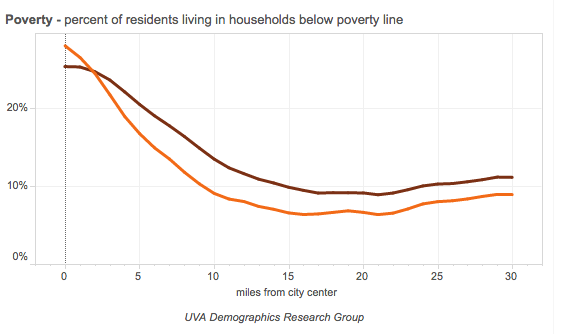There’s a new narrative going around about place. Like so many narratives, it’s based on a perceptible grain of truth, but then has a degree of exaggeration that the evidence can’t support.

Cities, we are told, are becoming playgrounds of the rich. Last week, Quartz headlined Richard Florida’s recent talk about the future of cities as A world famous urbanist says New York becoming “gated suburb.” Florida is more nuanced in his talk–highlighting a handful of neighborhoods where rich families are living in large apartments (with garages!) in the city’s upper east side. But the nuance gets lost in the journalistic retelling that focuses heavily on Florida’s warning that urban revival has a “dark side” that is creating “winner take all” cities.
It’s certainly true that we’ve witnessed a considerable rebound in the condition of America’s cities. After decades of decentralization and urban decline, things have started turning around. Population in a few cities began growing in the 1990s, and after 2000 even more cities moved forward. In 2013, Brookings Demographer Bill Frey noted that cities had grown faster than their surrounding suburbs for two successive years and that this might constitute a “big city growth revival.”
The corollary of this narrative of city revitalization is that the suburbs are becoming poorer. The most definitive statement of this claim came in the Brookings Institution’s 2010 report, The Suburbanization of Poverty, which concluded: “By 2008, suburbs were home to the largest and fastest-growing poor population in the country.” The Brookings report showed that more poor people now lived in suburbs than in central cities and that suburban poverty was growing faster.
Statistically, both those statements are completely true. But let’s spend a minute unpacking that analysis. First, it helps to know how Brookings defines “city” and “suburb.” It defines city as the largest municipality in a metropolitan area, and “suburb” as virtually everything else. It turns out that by that definition roughly 70 percent of the metro population now lives in suburbs. So it’s hardly surprising that a majority of the poor no longer live in central cities.
The second part of the claim is that poverty is growing “faster” in suburbs. While that’s true, it’s from a far smaller base. But despite faster growth, poverty rates—the share of people living in suburbs who are below the poverty line—are far lower than they are in cities.
What’s more, dividing all urban space into just two categories (city and suburb) and reporting totals for each makes it seem like poverty is somehow increasing and evenly spread in every suburb. But that’s not true. Some poor suburbs are the older, first tier towns just outside the larger central city. For example, Camden and Hoboken New Jersey, East Hartford, Connecticut and Fall River Massachusetts–all struggling older cities are technically classified as–“suburbs” in the Brookings typology.
Alan Ehrenhalt made these kinds of claims that theme of his book, “The Great Inversion.” In it he argued that the half century long pattern of wealthy people living in the suburbs and the poor being concentrated in the central city was inverting.
As a description of the direction of change, these stories are right: many city neighborhoods are attracting more better educated and higher income residents. And some suburbs—usually older, blue collar ones—are seeing a growing number of families living in poverty.
Wildly overstating the trend
But the narrative of “rich cities, poor suburbs” represents a vast overstatement of the scale of these changes.
The magnitude of these changes hasn’t yet come close to fundamentally altering the pattern of income and urbanization in the US. It is still the case that the poor are disproportionately found in or near the city center, and the wealthy live in the suburbs.
Rather that using a crude binary classification of cities and suburbs, with cleavages drawn at arbitrary and often random political boundaries, it is much more illuminating to look at the exact pattern of correlations between neighborhood income and distance to the central business district. The University of Virginia’s Luke Juday has mapped this data to illustrate the relationship between centrality (distance to the center of the central business district) and income. (It is available on the web at http://statchatva.org/changing-shape-of-american-cities/). Helpfully, Juday has made this calculation for 1990 and for 2012 using Census data.
Here’s what the poverty gradient looks like for the average of the 50 largest U.S. metropolitan areas. The vertical axis shows the poverty rate (higher is poorer) and the horizontal axis shows the distance in miles from each neighborhood and the center of the CBD. (Values near zero are neighborhoods in and near downtown, higher values represent the more distant suburbs).
 Data for 50 largest US metro areas, 1990 (orange), 2012 (brown)
Data for 50 largest US metro areas, 1990 (orange), 2012 (brown)
Here’s what these data show. First and foremost, poverty rates are highest in the center and lowest toward the suburban fringe. The farther you get from the center, the lower the poverty rate. So despite talk of “gated cities” and “poor suburbs,” the so-called great inversion simply hasn’t happened yet. If you look closely at the difference between the poverty line for 1990 (orange) and 2012 (brown), you’ll see there is a difference. Poverty rates are now somewhat lower in the center than before, and somewhat higher in the suburbs than before.
It will be many decades before city poverty declines to suburban levels
It’s useful to do the mental exercise of estimating how long, at current rates of change, it would take for poverty rates to equalize across the metropolitan landscape (i.e. for the line to go from downward sloping left-to-right to nearly flat (meaning equal rates of poverty everywhere). And note: this would not be an imagined Paris-style inversion, where the rich live in the center, and the poor in the suburbs, but just simply an equal level of poverty across the metro region.
In the 22 years between 1990 and 2012, the central city poverty rate (1 mile from the center of the CBD) declined from 26 percent to 25 percent, while the poverty rate 20 miles away in the suburbs increased from 7 percent to 9 percent. Poverty in the center was on average 15 percentage points higher in the center than in the periphery. The gap between the two areas thus closed by 3 percentage points. At 1.5 percentage points per decade, it would take until the end of the century before poverty levels equalized between the urban core and twenty miles out.
Unless there’s a tremendous acceleration of this rate of change, an actual inversion is several decades away. And the idea that these lines would be inverted, i.e. sloping upward and to the right, meaning that poverty was higher in the suburbs than in the center, simply shows almost no signs of happening.
To be sure, a few neighborhoods have seen dramatic change, but to conclude that entire cities are becoming “gated suburbs” is a wild exaggeration of what so far, is a vary modest trend that has slightly ameliorated the centralized pattern of poverty in the US. The overall pattern of poverty in New York has hardly changed since 1990; the highest poverty rates are between 5 and 10 miles from the city center, and are more than triple the poverty rate in suburbs more than 15 miles away.
While the high profile gentrification of some urban neighborhoods attracts widespread media attention, the real story of neighborhood change in the United States is the persistence and spread of concentrated poverty. Over the last four decades, only about one in twenty urban high poverty neighborhoods rebounded—meaning that they went from a poverty rate of more than 30 percent in 1970 to less than 15 percent in 2010. (Fifteen percent is roughly the national average poverty rate). In that same time, the number of high poverty neighborhoods tripled, and the number of poor people living in them doubled. And these neighborhoods of concentrated poverty—which Raj Chetty’s work shows are toxic to the children growing up there—are disproportionately concentrated in central cities.
How can we harness this change to tackle real problems?
Rather than raise the alarm about what is in the vast majority of cities a very slow-moving non-crisis, our energy might be better spent thinking about how we might leverage the growing interest in urban living into a force that will undo the pattern of income segregation that has characterized the last half century or so of suburbanization — what Robert Reich called the secession of the successful.
Cities have been plagued for decades by desertion and disinvestment. The middle income families that could provide the fiscal and civic support for a vital city have been exiting. Now that some younger people are starting to come back to invest in city neighborhoods, commit to city schools, and exercise citizenship, there’s a huge opportunity to leverage this momentum to address the city’s poverty and segregation problems.
There are some practical policy steps that every city could take to make sure that the benefits of revitalization are widely shared. For one thing, revitalization means new jobs in or near places that have long been said to suffer from a “spatial mismatch.” Training and placing local residents for jobs in everything from construction (building and rehabilitating housing) to working in the growing retail and service businesses that are expanding in cities would directly address economic needs. The good news, as we’ve shown at City Observatory, is that the decentralization of job growth that has proceeded for decades is at an end, and jobs are moving back into cities.
Cities can also tap the added investment associated with revitalization to create more affordable housing in revitalizing neighborhoods. That’s exactly what Portland has done—dedicating about a third of the tax increment revenues from new housing development to pay for subsidized housing in urban renewal areas. The city’s tony new Pearl District is home to galleries, restaurants, theaters, high end condos and new market rate apartments. It also has more than 2,300 units of affordable housing, subsidized by tax increment financing. The result, far from being a “gated suburb” is a lively, walkable mixed income neighborhood with more economic diversity in a small area than any other part of the region.
There’s no reason why cities can’t use the economic momentum created by the interest in city living to build more affordable housing in revitalizing neighborhoods and create the kind of just, inclusive communities that we all seem to think would be a good idea. If we view economic integration as an important objective, the trends we see in cities ought to be regarded as shining examples of opportunity, rather than an inevitable “dark side” of the urban renaissance.
The apocalyptic exaggeration of nascent trends generates headlines but it’s a poor basis for making sensible policy. For too long, urban policy in the United States consisted of little more than triage and managed decline. If we’re really optimistic about cities, then we ought to be focusing our attention on constructive ways to manage this historic opportunity.
